By DARLENE WEST
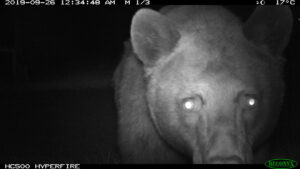
British Columbia, Canada
In the mornings, I like to follow our border collie on his nose-to-the-ground rounds: out to the creek at the edge of our land; up to the vegetable garden near the foothills; across the back yard. Sometimes, the hair on the back of his neck stands up.
Our farm land in southern British Columbia borders a mountainous wilderness. My husband and I find curiosities on our property all the time: peaches picked from our trees; tunnels under our fences; grape cluster stems, cleaned of berries. Now and then, feeding our fascination with the unknown: strips of grass, chiseled out of the lawn, coiled like jelly rolls. What roams around here at night after we turn out the lights?
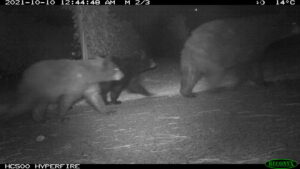
One winter, years ago, we bought a motion-activated camera, the kind used by hunters for tracking game, complete with software called Buckview for importing photos to your computer. We moved the camera around our farm land and over the months, over the seasons, a parade of visitors turned up. Checking Buckview became addictive. I made lists of animals we’d expect to see in this corner of the province, and as they wandered out of the night in black and white, I checked them off.
The camera, an infrared, emits a tiny red beam when it fires, a faint glow that some animals find intriguing: a coyote, cruising a game trail in the moonlight, gazes into the lens; a bobcat, crossing the frozen creek, glances up, eyeballs aglow. Mule deer, black bear, badger, rabbit, raccoon, skunk.
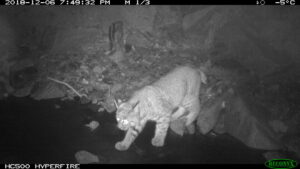
Because the camera fires only when it detects movement, animals appear to materialize in dream-like succession. A coyote crawling under a fence at 9:12 p.m. looks to be right on the heels of a raccoon that squeezed though the same opening a half-hour before. The bobcat glancing up at the camera at 5:02 a.m. seems to be nose-to-tail with the coyote that arrived at 1:36. A black bear stumbles out of the sagebrush, fore claws long and pearly in the light of the infrared flash, followed by a skunk. On some nights, the wind sets the camera off, triggering blurry images of antelope brush. Occasionally, the camera catches only an antler, a furry rump or a nebulous ear.
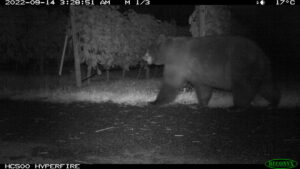
Nighttime photos of wildlife in North America taken over a century ago with more basic equipment, and undated, have been described as “outside the world of clocks and watches.” Photos from our modern camera, dated to the second and tagged with the temperature and phase of the moon, seem, as well, to belong to another realm.
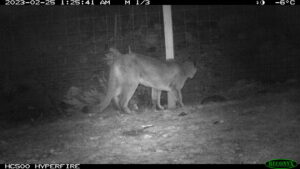
One moonlit night, not long ago, our camera caught a cougar padding along our fence line—all muscle. Long tail slung low. The image took my breath away. I hadn’t even bothered putting cougar on my animal list, although thousands of them inhabit this province. Cougars prowl at the top of the food chain: elusive, unseen.
In this part of the province, known for dark skies, we can step outside on a clear night and tour the galaxy, pondering the possibility of alien life in our galactic backyard, our place in the cosmos. Are we alone here?
Under the stars, a cougar pads out of the night, on a well-worn pathway directly behind our house. Oblivious to our proximity, I assume. In front of a camera, the cougar pauses, inspecting an excavation under a fence. Somehow, we co-exist here, all of us, traveling through time and space, traveling the same paths in our separate realms.
Darlene West has been reflecting on place and the meaning of home for years. She has lived in Greece, Malta, Indonesia, and several Canadian provinces and has worked as a business reporter, a trade journal editor, and a travel guide author. Her essays and articles have appeared in The Morning News, The Globe and Mail, Canadian Geographic, and many other publications. She and her husband live in the Okanagan Valley, British Columbia.
Photos by author.




